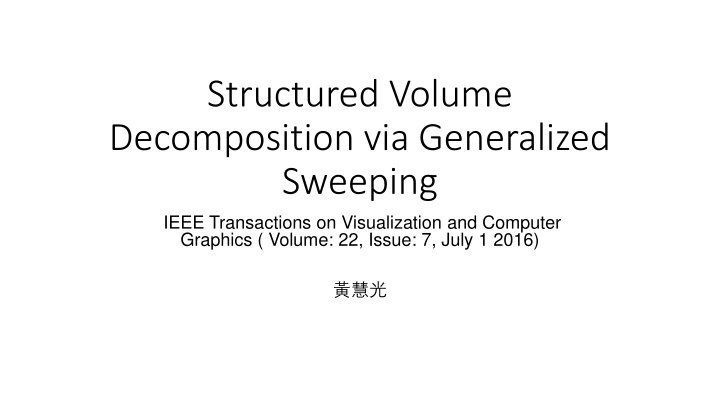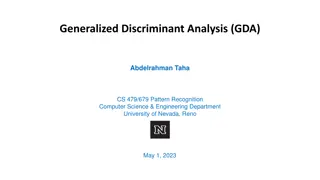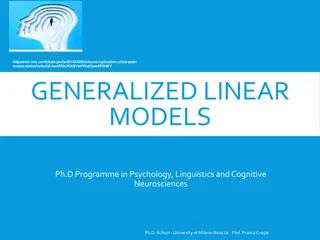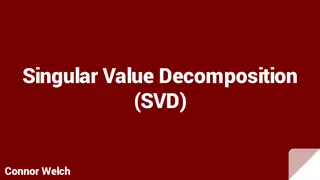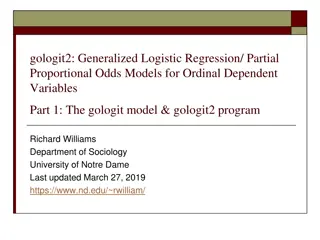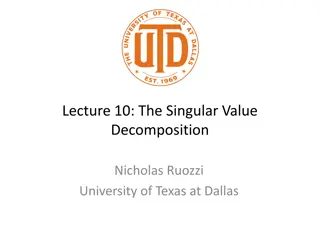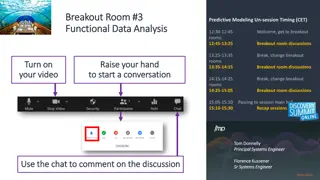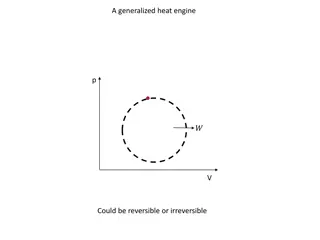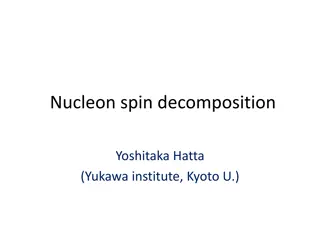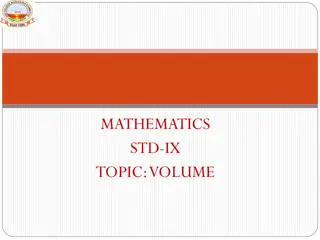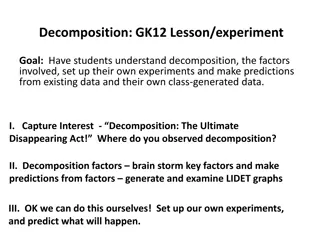Structured Volume Decomposition via Generalized Sweeping
This paper introduces a new technique for generating a simple and predictable structured hex-mesh, providing better convergence properties and more space efficiency in computer graphics and engineering applications. The method involves computing 3D harmonic function decomposition, slicing the object, and flattening each slice using specific implementations.
Download Presentation

Please find below an Image/Link to download the presentation.
The content on the website is provided AS IS for your information and personal use only. It may not be sold, licensed, or shared on other websites without obtaining consent from the author.If you encounter any issues during the download, it is possible that the publisher has removed the file from their server.
You are allowed to download the files provided on this website for personal or commercial use, subject to the condition that they are used lawfully. All files are the property of their respective owners.
The content on the website is provided AS IS for your information and personal use only. It may not be sold, licensed, or shared on other websites without obtaining consent from the author.
E N D
Presentation Transcript
Structured Volume Decomposition via Generalized Sweeping IEEE Transactions on Visualization and Computer Graphics ( Volume: 22, Issue: 7, July 1 2016)
introduction In a variety of computer graphics and engineering applications such as physically based deformation or free-form deformation, volumetric representations are often required better convergence properties and more space efficiency However, to date none of the existing techniques in the literature allows practitioners to efficiently generate a hex-mesh with controllable orientation 2015 In this paper, we introduce a new volumetric decomposition technique for the generation of a simple and predictable structured hex-mesh.
overview Computing 3D Harmonic Function Decomposition of H (H is the set of tetrahedra 2D SKELETAL STRUCTURE 3D SKELETAL SURFACE PARAMETERIZATION AND HEX-MESHING
3D Harmonic Function In this work, the harmonic function u is computed by first discretizing Laplace s equation using Galerkin s formulation [32]. The set of vertices ??is decomposed into a set of constrained vertices ??, and a set of free vertices ??for which a solution is sought. In our framework, the user has full control over u by defining ??through vertex selections directly made on H.
Decomposition of H Given the harmonic function u, the object is decomposed into a set of slices ?i. ?iis extracted using marching tetrahedra [33]. Depending on the choice of ??and resulting saddle points [34] ?irepresented as triangle meshes with boundaries.
Finally, each slice ?iis flattened using the CGAL [37] implementation of LSCM [28]. The boundary of the flattened ?iis approximated with a periodic B-spline curve using the method proposed in [30].
2D SKELETAL STRUCTURE In this section, we provide the definition and computation of the inner structure of a planar level set ?i. An inner structure ?iis defined as a polygon with N vertices in the interior of ?i whose corners ?? represents the characteristic of boundary , e.g., the primary orientation or curvature extrema with controllable complexity (set N = 4) ?map one-to-one to the ?i(boundary i) separating points ?? ?. ?i
We adopt a two-stage approach to determine the corners of ?i. First, we determine the locations of the corners on ?i(boundary i) based on its configuration. Second, we project the obtained corners on ?ito the interior of ?i Figure 3 illustrates this process.
Fig. 3: 2D structure extraction. (a) Flattened level set ?iwith its bounding box guided by its medial axis ?i and boundary corners ??. This bounding box is different from the one (the light green box) obtained by performing PCA on ?i. (b) The corners of ?iare found on the iso-contour by the one-to-one mapping between ??and ??. The offset distance d = ??/3, where ??is the maximum scalar value of a distance field computed from ?i.
1. Corner Point Extraction Given ?iwe follow the approach to compute its medial axis. The medial axis is the locus of centers of maximally inscribed circles that are tangent to the boundary. The contact points of each maximal circle with the boundary curve are called foot points. The computed medial axis for ?iis effectively denoised because it is computed from a smoothed curve. It can be further simplified with an area-based filtering.
Figure 4a shows a slice of a twisted U-shape model and its simplified medial axis. For each branch of the medial axis, if the area (for example, the dotted area in Figure 4a) bounded by its branch point, corresponding foot points and the boundary between foot points is smaller than 1/10 of the area of the slice, then we remove this branch. At this moment, if the simplified medial axis has only two end points, then we trace from the end points to the internal points, until the separation angle between the foot points of the current medial axis point is larger than a predefined value (we use 120 in this work).
Otherwise there are more than two end points in the medial axis, and in this case we compute a principal component analysis (PCA) of the medial axis curves, to obtain the dominant direction from which to extract the bounding box. Once the bounding box is computed and the corners are mapped onto the flattened slices, the corner points are inversely mapped onto the original (non- planar) slices. Note that the bounding box of the medial axis may not produce desirable corners. In addition, for more symmetrical slices (e.g. circular shape), the orientation given by the PCA is less reliable. The corners of both situations will be adjusted by a smoothing process discussed next. (a) Flattened level set ?iwith its bounding box guided by its medial axis ?iand boundary corners ??. This bounding box is different from the one (the light green box) obtained by performing PCA on ?i.
2. Computing the Corners of the Interior Structure To obtain the corners of the inner structure Qi , we first compute a distance field with the distance value as 0 for boundary vertices. Next, we compute an iso- contour in the interior of ?icorresponding to a distance value d based on the obtained distance field. 1) we can always locate the four interior corners by following the gradient directions of the distance field on ?i; 2) boundary and interior contour are partitioned into four pieces by the four corners. For each piece of the interior contour, the to be matched interior points can be found by accumulating chord length parameterization using the same ratios as boundary curve.
Corner Point Matching Over Level Sets After the corner points at individual level sets are extracted, they are matched between adjacent 3D level sets for the construction of a 3D inner skeletal surface (Section 5).
To determine the correspondence between corners at adjacent level sets, we employ a distance based greedy algorithm, modified by using the ratio of the eigenvalues of the PCA on the medial axis
When a bifurcation occurs, emphasis is placed on the continuity of the adjacent chains from the previous levels wherever possible to maintain good spacing of the corners. For example, in Figure 4b, the invalid match (shown by the red dash line segment) loses the continuity. The adjacent chain in the previous slice becomes non- adjacent after bifurcation. The correct matching is shown by the cyan line segments. However, forcing continuity of chains can lead to distortion. As shown in Figure 4b, the matching line segments in the right are almost tangent to Li+1. Thus, the quad-region (shaded) formed by these four corners is skewed, leading to distortion in the subsequent hex-mesh. This is due to the independent nature of the extraction of the corners at their individual level sets and the rapid change of the surface features along the gradient of the harmonic function. We introduce a smoothing process to remove this noise and reduce distortion.
For each chain, we use the corresponding vertices on each ?ito define a Schoenberg Variation diminishing spline approximation (SVDSA) [38]
3D SKELETAL SURFACE we now describe how to match the inner structure Qi through adjacent level sets to form a partitioning surface S (in 3D) (see Figure 9 for some examples), which is referred to as the inner skeletal surface. Based on the matched corners determined by Algorithm 1, we identify the corresponding matched edges of ?iand ?i+1, which are connected to construct a quadrilateral face.
First, computing a small segment on the surface that crosses the saddle point and intersects with ?iat ?0and ?1, respectively (i.e., the red curved segment in Figure 6b). A new section, referred to as a saddle patch and formed by the curve ?0?1and the edges ?0?1, ?0?0, and ?1?1can then be mapped to the two unmatched components (the shaded regions in Figure 6c). In practice, a short segment across the saddle point on the surface can be obtained by computing two separatrices starting from the saddle point along the incoming (outgoing) gradient flow direction for a splitting (merging) bifurcation. The computation of these separatrices is terminated when they reach the level set ?i(?i+2for merging).
Second, pushing down ?0?1along the negative harmonic gradient direction as long as ?0?1is still above ?i 1(Figure 6c), since ?0?1?0?1is a degenerate element as the four corners are almost collinear. Third, by creating a saddle patch, computing the mapping between ?iand ?i+1. However, this solution leads to a T-junction configuration when considering ?i and ?i 1since ?ihas been split into two components in the previous process. See Figure 6d for an illustration. Specifically, if a line segment enclosed by the shaded ellipse is not added in ?i 1, a T-junction configuration occurs.
Bifurcation improvement The above basic bifurcation handling introduces a valence-6 extraordinary node at each side of the bifurcation on the boundary quad mesh (orange dot in the left figure of Figure 8b). This may lead to large distortion in elements at bifurcations whose neighborhood is relatively flat.
To lessen the distortion, instead of associating the two unmatched components to a section across the saddle point as shown in Figure 6c, we map them to two sections as shown in Figure 8a. This splits the valence-6 (the number of neighboring hexahedral elements) extraordinary point into two valence-5 nodes (Figure 8b). This adds an additional component at the bifurcation (e.g., the purple region in Figure 8a). Note that this improvement is not required and can be selected by the user according to the surface characteristics around the bifurcations. We have applied this improvement to the kitten, fertility, blade, and rocker arm models in our experiments.
PARAMETERIZATION AND HEX-MESHING This section describes how to compute a seamless 3D parameterization and induce hex-meshes with large hexahedral components, after constructing S.
Parameterization: Similar to computing S, one parameterization direction w is provided by harmonic function u(x, y, z). The computation of a 3D parameterization can be simplified by two steps: 1) compute a 2D parameterization f?of ??based on its ??; 2) match f?and f?+1to obtain a 3D parameterization F. Hex-meshing: The hex-mesh is constructed in two steps. First, an all-quad mesh is obtained by following the isolines of the integer values of the 2D parameterization for each level set. Second, all the quad meshes are matched in the same fashion as the construction of the 3D parameterization.
RESULTS AND DISCUSSION For all the models shown in this paper, at most 600 slices are used for the cutting, which takes up to 2 minutes to compute. The corner extraction (including medial axis computation) takes one min per slice. The time spent on the generation of hex-meshes ranges from 5 seconds to 2 minutes, depending on the mesh resolution All timings are obtained on a PC with Intel i7 2670QM 2.2GHz CPU and 8GB RAM In Figure 11, the kitten model is meshed from two different choices of harmonic functions, one with bifurcation and one without bifurcation.
Compared to existing methods, the hex-meshes generated by our method typically have simpler structure, which is helpful in applications in graphics and engineering
